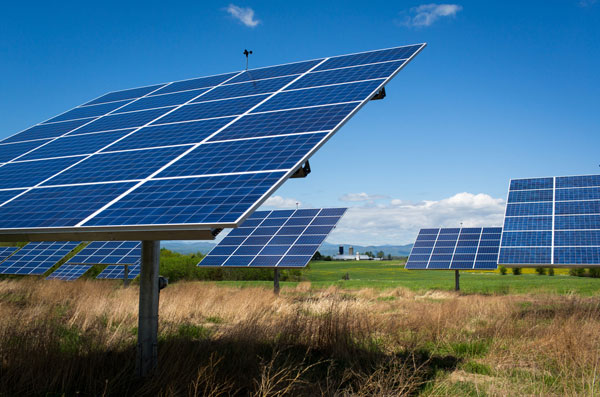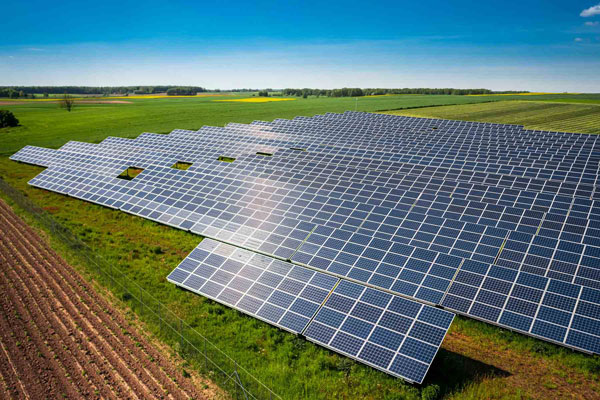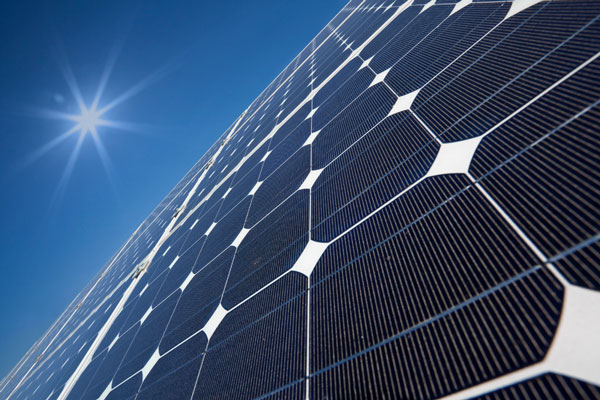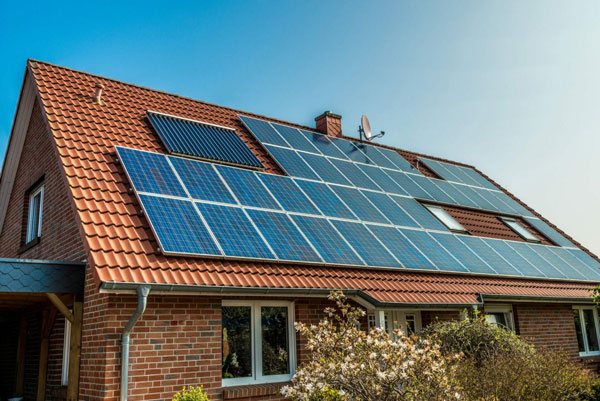Cost Benefits
Polycrystalline solar panels are considerably cheaper than monocrystalline panels. They usually are 10-20% less expensive and, for that reason, they are typically the domain of both residential and commercial users. EnergySage reports the national average price of monocrystalline panels is just over $3 per watt as of July 2018 and polycrystalline panels average $2.50 to $3 per watt of capacity. This price differential may lead to large case savings such as in the case of big installations.
Lower Manufacturing Costs
Ploycrystalline panels can make use of surplus silicon left over from the manufacture of single crystal panels and consequently are far simpler and cheaper to produce. Multiple silicon fragments are melted together, to be made into the wafers instead of a single crystal of silicon. This nearly eliminates waste of the silicon material, saving on the cost to produce the cells in the first place. According to the National Renewable Energy Laboratory (NREL), this reduces manufacturing costs by over 50% in its simplest form.
Affordable for Consumers
The lower costs to produce translate into a reduction of the final price for customers. So how does the price of 5 KWp Polycrystalline Solar System compare? For example, a standard 5kW house solar install cost with Polycrystalline panels could be at between $12,500 and $15,000 before any incentives. This translates to a $2,500 - $5,000 savings advantage when compared to a similar system utilizing monocrystalline panels. These cost-reductions make the ability of solar power far more affordable to a much larger swath of homeowners.
Large-Scale Project Savings
The savings are even higher for commercial and utility scale projects. Polycrystalline would be a standard choice and save the customer tens of thousands of dollars on their installation if it was for one of the larger installers. A Solar Energy Industries Association (SEIA) report stated that the capital expenditure (CapEx) on utility-scale solar farms using polycrystalline panels can be expected to be encompass a decrease of 10-15%. It makes the heat guns cheaper so products are competitively priced and payback can be much quicker.
Competitive Market Pricing
The self-explanatory name of this type of panel is notable for its widespread availability and competitive market pricing. Different suppliers also provide a variety of products to the consumers which means they can get the best seecfit out of their needs. Mass-produced, high-quality polycrystalline panels from major manufacturers (as Canadian Solar, Trina Solar, among others) are cheaper than leading monocrystalline models because of it. Such an excess in supply ultimately means that consumers have access to low-cost options and products they can depend on.
Financial Incentives
While they have a lower cost up front, polycrystalline panels are also generally eligible for the same grants, rebates, and other financial incentives as other kinds of solar panels. Incentives including federal tax credits, state rebates, and more can drop the installed cost even lower. For example, the federal Investment Tax Credit (ITC) enables homeowners and companies to claim 26% of the expense of a solar power installation in the form of a federal tax credit. This can mean a huge saving on top of the already cheaper price on the polycrystalline panels

Environmental Benefits
This simply means that polycrystalline solar panels contribute to a large extent in the conservation of the environment and hence a sustainable option for renewable energy.
Reduced Silicon Waste
Polycrystalline panels are made by melting several silicon fragments together rather than growing as the single crystal found in monocrystalline panels. More than 96 percent of the silicon material is utilized in this way, drastically cutting down on waste. This results in around 80% less silicon waste when producing monocrystalline, according to the International Renewable Energy Agency (IRENA).
Lower Carbon Footprint
Polycrylena has a lower carbon footprint than monocrystalline. According to the National Renewable Energy Laboratory (NREL), the carbon footprint of polycrystalline panels comes in about 20% smaller. The reduction is key to the fight against climate change because it lowers the total greenhouse gas emissions from the production of solar panels.
Energy Payback Time
Polycrystalline panels also have a relatively short energy payback time, making it the right choice for those who are concerned for environmental reasons. Research has demonstrated that polycrystallin panels may be paid back in just two years, depending on the location and installation configuration. These means they cancel out the energy it took to produce them very quickly, which means they are a cost-effective and green option.
Sustainable Manufacturing
Multi crystalline Panel- This Panel is manufacturing by low energy coverage than mono Crystalline Panel. This smaller requirement means a smaller environmental footprint. As an example, research by the European Commission's Joint Research Centre found that polycrystalline panels use almost 30% less energy to create compared to monocrystalline panels.
A Renewed Focus on Renewables
Manufacturing polycrystalline solar panels cheats global renewable energy goals by continuing the need for fossil fuels. This is in line with various global initiatives to reduce greenhouse gasses and promote use of clean energy. For instance, due to the fact that numerous jurisdictions have already determined that they want more renewable energy capacity, your choice to go with polycrystalline panels will help to further increase that capacity.
End-of-Life Recycling
It is easier to recycle polycrystalline panels at the end of their life cycle. These panels are also very recyclable, with a well-determined recycling process that extracts valuable resources like silicon, glass, and metal. The International Energy Agency (IEA) indicates that over 90% of the materials in a crystalline panel can be recovered and used anew, making it a part of a circular economy and lessening its environmental fall-out.
Efficiency in Various Conditions
Polycrystalline solar panels have excellent efficiency in different lighting conditions due to which; Solar power cost per KWh in India is very low, p makes it a versatile choice for various atmospheric conditions.
Performance in Low Light
Flexible solar panels polyVs entryFlexible solar panels polyTo add, even in low-light conditions, polycrystalline panels deliver because they are so reliable. This makes them only slightly less efficient than conventional panels (they maintain 15-17% efficiency) and actually helps them produce energy during rainy or cloudy days. Fraunhofer Institute for Solar Energy Systems concurs that amorphous panels are able to collect light from diffused sources better than monocrystalline panels: perfect for areas with significant cloud cover most of the time.
Temperature Coefficient
Temperature Coefficient of Polycrystalline Panels The same as monocrystalline panels, the temperature coefficient is a measure of how tightly the power output of your polycrytalline solar panels will vary with their temperature. Polycrystalline - These panels have a higher temperature coefficient than monocrystalline panels, which means they perform better in cooler climates. An per degree rise in temperature reduces their efficiency by c. 0.5% This feature is beneficial in locations that experience high temperatures which would otherwise cut their efficiency.
Shading Tolerance
Polycrystalline panels can withstand a degree of shadow rather than most other panel types These are made of multiple cells which means that they will still produce electricity in case one area of the panel is feeling the effects of shade. For instance, if a tree limb or broken yard waste partially shades the panel, the undisturbed cells will still open effectively, leading to a more predictable power output.
Real-World
Another study conducted by the University of California, San Diego compared the performance of polycrystalline and monocrystalline panels in different weather. Polycrystalline panels showed an overall higher yield compared to monocrystalline panels, particularly in low-light and diffuse-light situations. This makes them ideal for areas with unpredictable weather patterns.
Consistent Energy Output
One of the third reason is the energy output of polycrystalline panels remain constant, and it is so important to be able to have a constant power supply. They are also able to perform effectively in rain or shine - which guarantees constant energy production. This reliability is especially valuable for off-grid operations as these apps require a source of consistent energy.
Enhanced Longevity
Polycrystalline panels have a durable design that increases their expected lifespan. They generally include a 25-year warranty, which means that they will maintain their performance for years to come. Polycrystalline panels retain over 80% of their original efficiency even AFTER 25 years of usage according to SolarPower Europe, providing long-term value and trust for consumers.
Durability and Lifespan
One-Polycrystalline solar panelsPolycrystalline solar panels are known to be durable and have a long service life, so if you put them in your solar energy systems, you know that they are a reliable choice.
Robust Construction
A polycrystalline panel is made up of many silicon crystals that not only give them a more durable build... That configuration makes them extremely durable from physical damage and harsh conditions. A report from PV-Tech states that these panels can handle heavy snow loads, strong winds, and even hail storms, making them an ideal choice for many environments.
Long-Term Performance
One of the key benefits off polycrystalline panels is their longevity. Most of them have a lifespan of 25-30 years and many manufacturers even provide warranties that protect you the whole time. For instance, Canadian Solar and Trina Solar also offer 25-year performance guarantees, promising that their panels will remain at 80% efficiency or more for the duration of their useful lives. These warranties typically ensure an after a day and age that the panels will hold onto no not exactly 80% of the uprightness they conveyed from the get-go when the panels were fresh out of the plastic new.
Real-World Example
The National Renewable Energy Laboratory (NREL) conducted a study on the degradation rates of different solar panels For polycrystalline panels the rate was around 0.5% per year on average. This would imply that, at the end of 25 years, a polycrystalline panel would still be working at about 87.5% of its original capacity. Waxman And Some Of Its Brands Use Long-life Strategy With Slow Decreasing Rate Where Backsheet Performance Has Little Impact On Long-term Reliability And Power Output Of The Module.
Resistance to Environmental
Polycrystalline panels are specifically built to withstand exposure of UV radiation, humidity and temperature shifts. The materials in which they are encapsulated and the back sheets are designed to prevent damage to the products inside, which means they have a much longer useful life. Polycrystalline panels use high-quality materials in Solar Power World to stabilize the performance drop under harsh conditions
Low Maintenance Requirements
If maintenance is not something you are fond of, polycrystalline panels are ideal. They do not require frequent cleaning or servicing, which leads to less overall cost ownership. With traditional solar panels, manufacturers usually recommend an occasional visual inspection to check for obstructions and to keep them at peak efficiency. This very easy to operate intending to be just one of the major points for the factor that they are need to have for polycrystalline solar panels.
Proven Track Record
Both Residential and Commercial solar installations have extensively used polycrystalline panels. The fact that they have been tried and tested in some of the most testing and diverse climatic conditions is a testament to the quality. Large solar farms and residential installations in areas with less consistent weather patterns, for example, have reported the same performance by polycrystalline panels since they were first installed years ago. This widespread real-world use instils confidence in their build quality and long-term advantages.
Easy to Install
Polycrystalline solar panels are economical, so they are popular among home users, business users and, remote area users - they are simply and quickly installed due to their design.
Pre-Fabricated Frames
Which is one of the advantages of polycrystalline panels, as they have pre-fabricated frames. These frames make the installation process quick and easy with a pre-assembled state that just needs mounting. This creates over 50% cost savings according to Solar Power World, saving time and labor during the installation process compared to other mounting products for installers.
Lightweight and Manageable
These polycrystalline panels are lightweight, meaning they can be maneuvered more readily than other types of solar panels when installing the system. This makes them small and light enough to be carted up roofs and other high places easing labour. For example, a run-of-the-mill poly panel usually weighs a manageable 40 lbs for a two-person install crew.
Standardized Sizes
Even though the manufacturing process of Polycrystalline panels leaves some room for variance, they can be found in standardized sizes which allows these panels to be universally compatible with most (if not all) mounting systems. Incorporating a standardized design also allows installers to avoid fabricating mounting hardware from scratch for each installion, thus accelerating installation process even more. The fact that the rims are all the same size and bolt in the same place on any Tesla removes the risk of all kinds of installation errors, according to NREL.
Install via step-by-step Installation Process
Polycrystalline panels also have a simple installation process that can be broken down into a few defined steps.
- Site Evaluation - Analyzing the installation location to identify the best location for reliable performance due to optimal sunlight access.
- Installation of Mounting System: Securing mounting hardware to be mounted on the roof or surface
- Solar Panel Placing: Setting the polycrystalline panels over the mounting device.
- Electrical Connections - this is what connects the panels to the inverter and the electrical grid or battery storage system.
- System and User Acceptance Testing: Testing to confirm that the system is functioning effectively (System Testing) and is accepted for delivery to the end user (User Acceptance Testing).
All of this is intended to be intuitive and slick to accelerate installing overall.
Make your software product work with existing systems
Athena panels can be integrated with a large range of inverters and other peripherals powering your solar system, but enabling the full benefit from its electric and energy performance. In another sense, it makes them compatible with the present solar structure so they can be conveniently added to current solar arrangements for private or business applications. Monocrystalline and thin-film panels, such as those already used by many systems, can easily make room for polycrystalline panels with little to no adaptations needed.
Installer Recommendations
Polycrystalline panels are easy to install which is why solar installation companies advise using them. Installers have reported back to us on how easy and trouble-free these panels are to install. One of the top solar installation companies, for example, SunPower, highlights its polycrystalline solar panels as "fastest to install," which comes from their snap-together design.
Practical Application
A residential 6 kW system with polycrystalline panels was installed in less than 50 hours in this case study of Solar Reviews. The installation team credited their rapid completion to the user-friendly design of the panels and the prefabricated frames. This is a great example of how quickly and simply installing polycrystalline solar panels can be, this being why they are the panel of choice for a wide variety of projects.

Wide Availability
The broad availability of polycrystalline solar panels in the market also means that consumers have a great range of products and suppliers to choose from.
Multiple Manufacturers
Polycrystalline panels are some of the most widely available panels manufactured in countries around the world. The largest panel manufacturers, including Canadian Solar, Trina Solar and JinkoSolar The most affordable of the lot sell a wide range of polycrystalline models to suit almost any budget or requirement. As such, production is extensive and thereby facilitated to enable easy access to panels that meet individual demands by consumers.
Prevalent Distribution Ecosystems
Favorable distribution network executed by these manufacturers help them to ensure the ready availability of polycrystalline panels in various regions. This availability means that both residential and commercial customers will have an easier time procuring the unit. That means that a large percentage of the global market will have local access to Canadian Solar's polycrystalline panels, which are good examples of locally and locally accessible sales models.
Competitive Pricing
This makes polycrystalline technology widely accessible on the market with competitive prices. This benefits consumers as it enables them to enjoy better deals and discounts. Prices for polycrystalline panels in the United States have plunged over the past decade, in part to the sheer number of suppliers, according to the Solar Energy Industries Association (SEIA).
Variety of Options
There are a number of different polycrystalline panels on the market, giving consumers plenty of options that come down to efficiency, size, and cost. This diversity means that there is a polycrystalline panel that will suit any project, whether it is a small residential install, or a large commercial solar farm. Trina Solar is a good example, as the company has a range of panels with different power and efficiency levels that can be selected for different applications.
Spare Parts and Accessories Availability
Considering that used polycrystalline panels are common, you can easily get spare parts and all the hardware accessories. This access helps with maintenance and repairs by making it easy for replacements to be found quickly. Solar Power World notes that the availability of compatible components plays into polycrystalline solar's dependability and serviceability throughout the longterm.
Local and E-commerce Stores
There are also polycrystalline panels available in great supply that can be bought through local retailers and online;reaching thousands of potential consumers. These are available on most online marketplaces such as Amazon or solar equipment websites and can be distinctly polycrystalline, usually even with reviews and ratings to indicate the quality of the product. This also translates to a more personal experience, as most local solar retailers run local operations.
Practical Application
Polycrystalline solar panels represented over 60% of global solar panel shipments in 2022, according to GTM Research. Their extensive presence in the market highlights their very strong approach. The Bean report said a strong, established supply chain ensures that polycrystalline panels are in high demand and that they will continue to be a stable choice for solar projects globally



